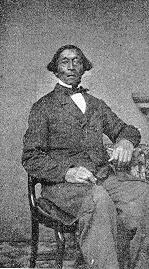Stephen Myers (abolitionist) facts for kids
Quick facts for kids
Stephen Myers
|
|
|---|---|
 |
|
| Born | c. 1800 |
| Died | February 13, 1870 (aged 69–70) |
| Nationality | American |
| Occupation | Abolitionist, Newspaper editor |
Stephen Myers (born around 1800, died 1870) was a brave leader who fought against slavery. He was known as an "abolitionist." He also helped people escape slavery through a secret network called the Underground Railroad from the 1830s to the 1850s. Stephen Myers also ran several newspapers that shared ideas about ending slavery. Some of these papers were The Elevator and The Northern Star.
Contents
Early Life and Freedom
Stephen Myers was born into slavery in Hoosick, New York, around the year 1800. When he was 18 years old, he gained his freedom. This freedom was given to him by Lt. Colonel Warren of Vermont.
In 1827, Stephen met Harriet Johnson and they got married in Troy, New York. Stephen and Harriet lived in different homes in Albany before settling at 198 Lumber Street.
Fighting for Freedom
Stephen and his wife Harriet were very important in helping people escape slavery. They offered safe places for people seeking freedom. They also gave them money and support through a group called the Vigilance Committee. This committee helped people who were escaping slavery.
Stephen Myers also worked on projects to help African Americans. He organized the Florence Farming and Lumber Association. This group helped people find jobs and build businesses. He was also a leader in the American Council of Colored Laborers. This group helped people learn important work skills.
Myers also worked to get African Americans the right to vote. He was a key person in the New York State Suffrage Association. He spoke to lawmakers in New York to push for voting rights.
Helping the Underground Railroad
In the 1850s, Myers joined the Albany Vigilance Committee. He was the chairman of this group for over three years. The Myers's home was a very important place for the committee. It was where they raised money and received mail. It also served as a safe house for people escaping slavery on their journey north.
Many people who fought against slavery saw Myers as a vital helper of the Underground Railroad. He worked with other famous abolitionists. He wrote articles with Samuel Ringgold-Ward. He also spoke at churches and shared the stage with Frederick Douglass.
Myers later combined his newspaper, The Northern Star, with another paper called True American. This new paper was named The Impartial Citizen. It was published in Syracuse, New York. The paper stopped publishing after two years. This happened when its editor, Samuel Ringgold Ward, had to leave for Canada.
Later Years and Legacy
Stephen Myers spent the rest of his life helping the Underground Railroad. He also helped recruit soldiers for the United States Colored Troops. These were African American soldiers who fought in the Civil War.
His wife, Harriet, passed away in 1865. Stephen Myers died five years later, on February 13, 1870. He passed away at his son's home in Albany and was buried at Albany Rural Cemetery.
See also
- Stephen and Harriet Myers Residence

